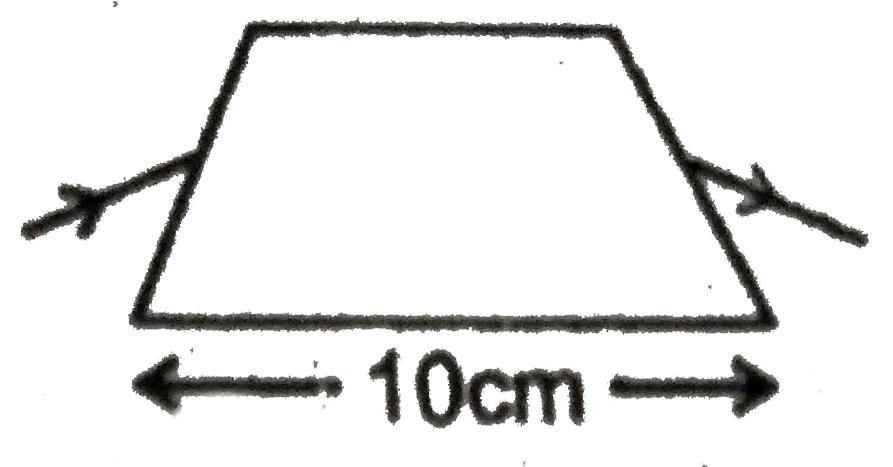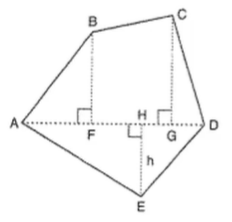Look at the ray diagram shown what will be the focal length of the 1st and the 2nd lens if the incident light ray is parallel to emergent ray.A −5cm and −10cm B +5cm and +10cm C −5cm and +5cm D +5cm and +5cm
The correct option is C.Explanation:For first lens convergent ray becomes parallel to principal axis after refraction.So f1 = +5 cm.For second lens ray parallel to principal axis becomes convergent and parallel to incident ray.So focal will length of second lens will be x as shown in figure.
Related Solutions
Find volume of the cuboid when l=5cm,b=10cm and h=5cm
View SolutionThe focal length of a lens is -50 cm. The nature and power of the lens is
View SolutionTwo thin lenses are placed 5cm apart along the same axis and illuminted with a beam of light parallel to that axis. The first lens in the path of the beam is a converging lens of focal length 10cm whereas the second is a diverging lens of focal length 5cm. If the second lens if now moved toward the first, the emergent light
View SolutionTwo thin lenses are placed 5cm apart along the same axis and illuminted with a beam of light parallel to that axis. The first lens in the path of the beam is a converging lens of focal length 10cm whereas the second is a diverging lens of focal length 5cm. If the second lens if now moved toward the first, the emergent light
View SolutionArrange the following glass convexlenses in increasing order of their focal power. a) R_1=12cm R_2=6cm b) R_1=10cm R_2=5cm c) R_1=15cm R_2=5cm d) R_1=15cm R_2=10cm
View SolutionIf .find s.
View SolutionIn a rectangle,the length is longer than the breadth by 5cm. If theperimeter is 70cm, then the length and breadth are respectivelya) 15cm,20cmb)20cm,15cm c) 5cm,10cm d) 10cm,20cm
View SolutionThe focal length of the lens in a photographic camera is 5cm. what is the power of the lens?
View SolutionAn isosceles trapezium of reflecting material of refractive index and dimension of sides being 5cm, 5cm, 10cm and 5 cm. The angle of minimum deviation by this when light is incident from air and emerges in air is:

View SolutionAn isosceles trapezium of reflecting material of refractive index and dimension of sides being 5cm, 5cm, 10cm and 5 cm. The angle of minimum deviation by this when light is incident from air and emerges in air is:

View Solutionघनाभ की लम्बाई 5cm ,चौड़ाई 10cm ,तथा ऊंचाई 3cm है तब घनाभ का आयतन होगा -
View SolutionConstruct a triangle with 5cm, 5cm and 1cm. Is it possible or not ? Why?
View SolutionFind the area of the pentagon shown in Figure, if

View SolutionIf the perimeter of a square is 40cm, then the length of its each side is 20cm (b) 10cm (c) 5cm (d) 40cm
View SolutionIf the perimeter of a square is 40cm, then the length of its each side is 20cm (b) 10cm (c) 5cm (d) 40cm
View SolutionA convex lens of focal length 20cm and a concave lens of focal length f are mounted coaxially 5cm apart. Parallel beam of light incident on the convex lens emerges from the concave lens as a parallel beam. Then, f in cm is
View SolutionA convex lens of focal length 20cm and a concave lens of focal length f are mounted coaxially 5cm apart. Parallel beam of light incident on the convex lens emerges from the concave lens as a parallel beam. Then, f in cm is
View Solution" If the focal length of a magnifier is "5cm" calculate,the magnifying power of the lens for relaxed eye "
View SolutionAn object 5 cm in length is held 25 cm away a converging lens of focal length 10 cm. Draw the ray diagram and find the position, size and nature of the image formed.
View SolutionAn object 5cm in length is held 25cm away from a converging lens of focal length 10cm. Draw the ray diagram and find the position, size and the nature of the image formed.
View Solution